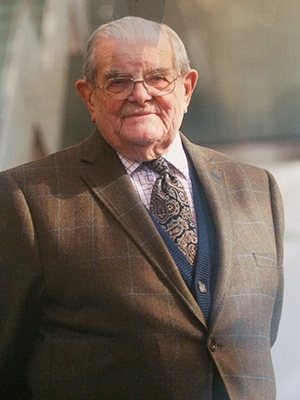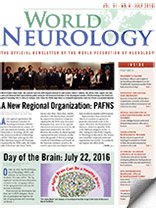By Johan A. Aarli, MD, and Raad Shakir, MD
 The World Federation of Neurology is remembering John Nicholas Walton, MD, who passed away in April at the age of 93. Walton, who served two terms as president of the WFN following his election in 1989, knew the organization better than anyone. His work in the WFN started from its inception in 1957. He succeeded Macdonald Critchley as editor of the Journal of Neurological Sciences when Critchley later became WFN president in 1965. He worked with Henry Miller as secretary general to shape the organization. Walton saved the WFN from bankruptcy with his compromise during the creation and later dissolution of the World Association of Neurological Commissions (WANC), which resolved the financial crisis of the WFN in 1966. He started the research group on neuromuscular disorders. He was elected first vice president during Richard Masland´s presidency. During this busy time at the WFN, he wrote Essentials of Neurology, which became a standard textbook for medical students. In 1968, he was promoted to a personal chair in neurology at England’s Newcastle University, and in 1971 he was appointed dean of the Newcastle Medical School. He was knighted in 1979, was appointed life peer in 1989 as Baron Walton of Detchant, and he sat in the House of Lords as a crossbencher.
The World Federation of Neurology is remembering John Nicholas Walton, MD, who passed away in April at the age of 93. Walton, who served two terms as president of the WFN following his election in 1989, knew the organization better than anyone. His work in the WFN started from its inception in 1957. He succeeded Macdonald Critchley as editor of the Journal of Neurological Sciences when Critchley later became WFN president in 1965. He worked with Henry Miller as secretary general to shape the organization. Walton saved the WFN from bankruptcy with his compromise during the creation and later dissolution of the World Association of Neurological Commissions (WANC), which resolved the financial crisis of the WFN in 1966. He started the research group on neuromuscular disorders. He was elected first vice president during Richard Masland´s presidency. During this busy time at the WFN, he wrote Essentials of Neurology, which became a standard textbook for medical students. In 1968, he was promoted to a personal chair in neurology at England’s Newcastle University, and in 1971 he was appointed dean of the Newcastle Medical School. He was knighted in 1979, was appointed life peer in 1989 as Baron Walton of Detchant, and he sat in the House of Lords as a crossbencher.
Walton´s presidency became the most constructive modernization phase in the history of the WFN, and he took personal care that the changes were constitutional. A central step of the reorganization was to establish a corporate status for the WFN. The chairs of the publications and the finance committees were now better integrated in the WFN structure. The responsibilities of the committees were now defined, and the committee structure was overhauled into a solid structure.
The secretariat became better integrated with the general structure of the WFN, resulting in the Research Committee having three directors at large and four-year terms. The Management Committee was renamed into a standing committee, and there was full agreement that the research groups should continue to play a central role in the federation’s activities. From then on, the WFN was to be governed by a board of directors to include the president, vice president, secretary-treasurer general, and Research Committee chair.
Walton was the fifth WFN president, and he kept in contact with the development of the organization. His last attendance at the World Congress was in Vienna 2013.
Walton’s achievements outside the WFN were immense. It has been said, “He did not join an organization unless he became president.” This includes his own medical school, where he was dean, warden of Green College Oxford, and president of the Association of British Neurologists, the Royal Society of Medicine, the General Medical Council, and the British Medical Association. His proudest position was as president of his beloved Bamburgh Golf Club in Northumberland.
It is said, that as a very keen golfer, he never won a trophy. To rectify that, at the age of 90, he managed to convince the golf club to buy a large cup for the oldest golfer to finish a round, and then he presented it to himself. Such was his wit and wonderful sense of humour.
All who knew him were very much aware of his sharp mind and his vast attention to detail. His advice on all matters related to the WFN and world neurology were most valuable to us all. The late Frank Clifford-Rose, who was WFN secretary-treasurer general, wrote about Walton in his biography in 1992, that there were few doctors who were legends, and very few were legends in their lifetime. His work throughout his career focused on muscular dystrophy, and he co-founded Muscular Dystrophy UK. It must have been very rewarding that the first drug for muscular dystrophy, ataluren, was licensed in 2016 during his lifetime.
Walton died of a glioblastoma multiforme, a diagnosis he announced in his bulletin to all United Kingdom neurologists, just before he passed away. Walton is survived by three children, five grandchildren, and 10 great-grandchildren.
